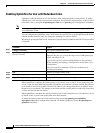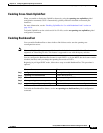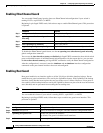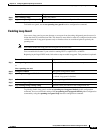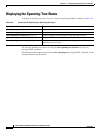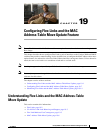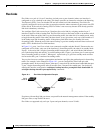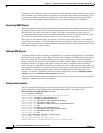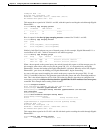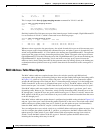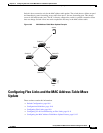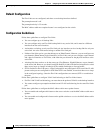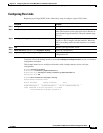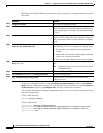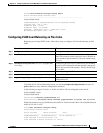
19-4
Catalyst 2960 and 2960-S Switch Software Configuration Guide
OL-8603-09
Chapter 19 Configuring Flex Links and the MAC Address-Table Move Update Feature
Understanding Flex Links and the MAC Address-Table Move Update
Though both Flex Link ports are part of the groups in normal operation mode, all traffic on the backup
port is blocked. So the normal multicast data flow is not affected by the addition of the backup port as
an mrouter port. When the changeover happens, the backup port is unblocked, allowing the traffic to
flow. In this case, the upstream multicast data flows as soon as the backup port is unblocked.
Generating IGMP Reports
When the backup link comes up after the changeover, the upstream new distribution switch does not start
forwarding multicast data, because the port on the upstream router, which is connected to the blocked
Flex Link port, is not part of any multicast group. The reports for the multicast groups were not
forwarded by the downstream switch because the backup link is blocked. The data does not flow on this
port, until it learns the multicast groups, which occurs only after it receives reports.
The reports are sent by hosts when a general query is received, and a general query is sent within 60
seconds in normal scenarios. When the backup link starts forwarding, to achieve faster convergence of
multicast data, the downstream switch immediately sends proxy reports for all the learned groups on this
port without waiting for a general query.
Leaking IGMP Reports
To achieve multicast traffic convergence with minimal loss, a redundant data path must be set up before
the Flex Link active link goes down. This can be achieved by leaking only IGMP report packets on the
Flex Link backup link. These leaked IGMP report messages are processed by upstream distribution
routers, so multicast data traffic gets forwarded to the backup interface. Because all incoming traffic on
the backup interface is dropped at the ingress of the access switch, no duplicate multicast traffic is
received by the host. When the Flex Link active link fails, the access switch starts accepting traffic from
the backup link immediately. The only disadvantage of this scheme is that it consumes bandwidth on the
link between the distribution switches and on the backup link between the distribution and access
switches. This feature is disabled by default and can be configured by using the switchport backup
interface interface-id multicast fast-convergence command.
When this feature has been enabled at changeover, the switch does not generate the proxy reports on the
backup port, which became the forwarding port.
Configuration Examples
These are configuration examples for learning the other Flex Link port as the mrouter port when Flex
Link is configured on Gigabit Ethernet0/11 and Gigabit Ethernet0/12, with output for the
show interfaces switchport backup command:
Switch# configure terminal
Enter configuration commands, one per line. End with CNTL/Z.
Switch(config)# interface gigabitehernet1/0/11
Switch(config)# interface gigabitehernet0/11
Switch(config-if)# switchport trunk encapsulation dot1q
Switch(config-if)# switchport mode trunk
Switch(config-if)# switchport backup interface gigabitehernet0/12
Switch(config-if)# exit
Switch(config)# interface gigabitehernet1/0/12
Switch(config-if)# switchport trunk encapsulation dot1q
Switch(config-if)# switchport mode trunk
Switch(config-if)# end
Switch# show interfaces switchport backup detail
Switch Backup Interface Pairs:
Active Interface Backup Interface State
GigabitEthernet0/11 GigabitEthernet0/12 Active Up/Backup Standby



